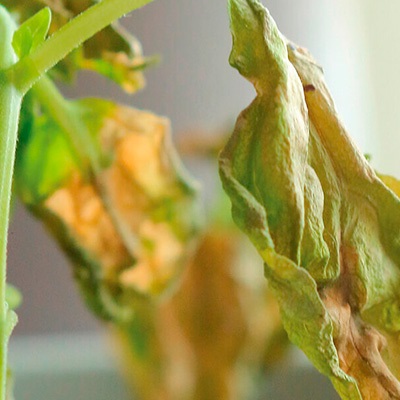
Root And Stem Rot
Rhizoctonia Sp., Fusarium Sp.
Pathogen:
Fungus
Type:
Risk:
HIGH
Pudrición de raíz y tallo
Plantas decorativas de jardín y/o interior


WHO CAUSES IT?
Rhizoctonia sp. and Fusarium sp. They are pathogenic fungi that cause serious diseases in various plants. Rhizoctonia sp. It is characterized by the formation of brown mycelium and sclerotia, resistance structures that allow the fungus to survive in the soil and remains of infected plants during unfavorable periods. The fungus is activated when environmental conditions are suitable, invading the roots and stems of plants through wounds or directly by penetration. Fusarium sp., on the other hand, is known for its asexual spores called conidia, which are dispersed primarily through water and soil. This fungus can also produce chlamydospores, which are resistance structures that allow it to persist in the soil for long periods. Both fungi can infect plants at any stage of development, causing root and stem rot, leading to a significant decrease in plant health and productivity.
SYMPTOMS
Root and stem rot in plants, caused by Rhizoctonia sp. and Fusarium sp., manifests itself with symptoms that severely affect the root system and the base of the stem. This disease begins with a yellowing and wilting of the leaves, followed by brown decay in the roots and stems, which can eventually lead to the death of the plant.
- Yellowing of the leaves.
- General wilting of the plant.
- Brown rot on the roots.
- Decomposition at the base of the stem.
- Roots with a watery texture and bad smell.
- Reduction in plant growth.
- Premature death of the plant.


TEMPERATURE AND HUMIDITY
20°C - 30°C
70% - 90%
TRANSMISSION ROUTES
Irrigation water, contaminated gardening tools, infected plant remains, direct contact between plants, infected seeds
Do you want to remove this pest? Choose how you want to treat it.
TREATMENTS
Chemical treatments
• AZOXISTROBIN 25% [SC] P/V
• CAPTAN 47.5% [SC] P/V
• CIPRODINIL 37.5% + FLUDIOXONIL 25% [WG] P/P
• FOLPET 50% [SC] P/V
• FOLPET 80% [WG] P/P
• PIRACLOSTROBIN 6.7% + BOSCALIDE 26.7% (I) [WG] P/P
Authorized treatments in organic farming
-
Biological control
• BACILLUS AMYLOLIQUEFACIENS subsp. plantarum (strain D747) 5% [SC] P/V
• BACILLUS SUBTILIS (STRAIN QST 713) 1.34% [SC] P/V
• CLONOSTACHYS ROSEA CEPA J1446 (GLIOCLADIUM CATENULATUM (CEPA J1446)) (1 x 10E 9 cfu/g) 900 g/kg [WG] P/P
• GLIOCLADIUM CATENULATUM (STRAIN J1446) 32% (2 X 10E8 CFU/G) [WP] P/P
• TRICHODERMA ASPERELLUM (STRAIN T25) (1X10E8 CFU/G) 0.5% + TRICHODERMA ATROVIRIDE (STRAIN T11) (1X10E8 CFU/G) 0.5% [WG] P/P
• TRICHODERMA ASPERELLUM (STRAIN T34) 12% (1.0 x 10E12 cfu/kg) [WP] P/P
• TRICHODERMA ATROVIRIDE (STRAIN I-1237) (1x10E8 cfu/g) 5% [WP] P/P
Recommendations
- Carry out a crop rotation with non-susceptible plants to reduce the accumulation of pathogens in the soil.
- Use certified disease-free seeds and plants.
- Apply appropriate preventive fungicides at critical moments of the crop.
- Avoid excessive irrigation and ensure good soil drainage.
- Improve soil structure by adding organic matter to promote a less favorable environment for fungi.
- Practice proper management of crop residues, eliminating remains of infected plants.
- Implement physical or biological barriers to limit the spread of the fungus.
- Use resistant or tolerant plant varieties when available.
- Carry out periodic soil analyzes to monitor the presence of pathogens.
Sponsored link
Sponsored link
Sponsored link
Sponsored link
Sponsored link
Sponsored link
Effective against all types of fungi
TREATMENTS
Homemade remedies
There are no home treatments
Natural allies
Chemical treatments
There are no treatments for this disease. Treatments are directed at the insect vectors that transmit it. See insect treatments.
RECOMMENDATIONS
- Check the back of the leaves frequently, especially in dry weather.
- Spray water on the leaves to increase humidity and prevent them from settling.
- Keep plants healthy with good watering and adequate light.
- If you see cobwebs or damage, clean the leaves with a damp cloth or pressurized water.
- Use potassium soap or neem oil every few days until they disappear.
REPELLENT PLANTS
Rosemary, Dill, Coriander
EFFECTIVE PRODUCTS TO ELIMINATE THIS PEST
Sponsored link
Sponsored link
Sponsored link
Sponsored link
Sponsored link
Sponsored link
Effective against all types of fungi
*Recommended treatments are still recommendations according to authority databases and in no way replace the guidelines established according to the legislation of each country.
*Products shown are recommendations and not our own products. As Amazon Associates, we earn revenue from purchases of recommended products.






















